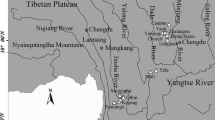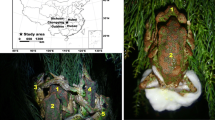Abstract
Sexual selection is critical to both reproduction and evolution. The effects of male–male competition and female choice regarding body size have been examined in a large number of taxa, including toad species. Males and females have different optimal reproductive strategies, achieving breeding advantages in discrepant ways. Further, the relative contributions of intra- and inter-sexual size selection vary among species. Thus, to understand the mechanisms affecting mating success, it is important to consider both male–male and male–female interactions simultaneously and elucidate their interrelationship. In this study, we measured body sizes of all mated and unmated individuals in a population of Asiatic toad (Bufo gargarizans) and counted fertilized eggs of several clutches. Based on correlation and regression techniques, we tested for female choice and intra-sexual competition among males relative to body size gradients, and we compared the relative importance of these two processes for mating success. Our results reveal that male–male competition and female choice simultaneously contribute to sexual selection in toads. Furthermore, both interactions are most intense among smaller toads. The synergistic trends of male–male competition and female choice support the mutual mate choice hypothesis and works to stabilize body size in B. gargarizans. Normal distributions of breeding success relative to body size were detected for both sexes, suggesting that medium-sized individuals enjoy a reproductive advantage in the population studied.






Similar content being viewed by others
References
Davies NB, Halliday TR (1977) Optimal mate selection in the toad Bufo bufo. Nature 269:56–58
Wilbur HM, Rubenstein DI, Fairchild L (1978) Sexual selection in toads: the roles of female choice and male body size. Evolution 32:264–270
Andersson M (1994) Sexual Selection. Princeton University Press, Princeton
Mclean M J. Testing the predictions of inter-sexual selection theory, using anurans as a model taxon. Dissertation for Master’s Degree. Dunedin: University of Otago, 2011
Shine R, Olsson MM, Moore IT et al (2000) Body size enhances mating success in male garter snakes. Anim Behav 59:4–11
Lourdais O, Bonnet X, Shine R et al (2003) When does a reproducing female viper (Vipera aspis) ‘decide’ on her litter size? J Zool 259:123–129
Reading CJ (2004) The influence of body condition and prey availability on female breeding success in the smooth snake (Coronella austriaca Laurenti). J Zool 264:61–67
Remeš V, Székely T (2010) Domestic chickens defy Rensch’s rule: sexual size dimorphism in chicken breeds. J Evol Biol 23:2754–2759
Mclean MJ, Bishop PJ, Nakagawa S (2012) Male quality, signal reliability and female choice: assessing the expectations of inter-sexual selection. J Evol Biol 25:1513–1520
Polák J, Frynta D (2010) Patterns of sexual size dimorphism in cattle breeds support Rensch’s rule. Evol Ecol 24:1255–1266
Williams GC (1975) Sex and evolution. Princeton University Press, Princeton
Dale J, Dunn PO, Figuerola J et al (2007) Sexual selection explains Rensch’s rule of allometry for sexual size dimorphism. Proc R Soc Lond B 274:2971–2979
Emlen ST, Oring LW (1977) Ecology, sexual selection and the evolution of mating systems. Science 197:215–223
Wells KD (1979) Reproductive behavior and male mating success in a Neotropical toad, Bufo typhonius. Biotropica 11:301–307
Andersson M (1982) Female choice selects for extreme tail length in a widowbird. Nature 299:818–820
Berven KA (1981) Mate choice in the wood frog, Rana sylvatica. Evolution 35:707–722
Johnstone RA, Reynolds JD, Deutsch JC (1996) Mutual mate choice and sex differences in choosiness. Evolution 50:1382–1391
Johnstone RA (1997) The tactics of mutual mate choice and competitive search. Behav Ecol Sociobiol 40:51–59
Candolin U (2003) The use of multiple cues in mate choice. Biol Rev 78:575–595
Bateson M, Healy SD (2005) Comparative evaluation and its implications for mate choice. Trends Ecol Evol 20:659–664
Trivers RL (1976) Sexual selection and resource-accruing abilities in Anolis garmani. Evolution 30:253–269
Olsson MM, Shine R, Wapstra E et al (2002) Sexual dimorphism in lizard body shape: the roles of sexual selection and fecundity selection. Evolution 56:1538–1542
Shine R (1978) Sexual size dimorphism and male combat in snakes. Oecologia 33:269–277
Robel RJ (1966) Booming territory size and mating success of the greater prairie chicken (Tympanuchus cupido pinnatus). Anim Behav 14:328–331
Searcy WA (1979) Sexual selection and body size in male red-winged blackbirds. Evolution 33:649–661
Price TD (1984) Sexual selection on body size, territory and plumage variables in a population of Darwin’s finches. Evolution 38:327–341
McElligott AG, Gammell MP, Harty HC et al (2001) Sexual size dimorphism in fallow deer (Dama dama): do larger, heavier males gain greater mating success? Behav Ecol Sociobiol 49:266–272
Schulte-Hostedde AI, Millar JS, Gibbs HL (2004) Sexual selection and mating patterns in a mammal with female-biased sexual size dimorphism. Behav Ecol 15:351–356
Devine MC (1984) Potential for sperm competition in reptiles: behavioral and physiological consequences. In: Smith RL (ed) Sperm competition and the evolution of animal mating systems. Academic Press, Orlando, pp 509–521
Bateman AJ (1948) Intra-sexual selection in Drosophila. Heredity 2:349–368
Weatherhead PJ, Robertson RJ (1979) Offspring quality and the polygyny threshold: “The sexy son hypothesis”. Am Nat 113:201–208
O’Donald P (1972) Sexual selections by variations in fitness at breeding time. Nature 237:349–351
Trivers RL (1972) Parental investment and sexual selection. In: Campbell B (ed) Sexual selection and the descent of man. Aldine Press, Chicago, pp 98–132
Cherry MI (1992) Sexual selection in the leopard toad, Bufo pardalis. Behaviour 120:164–176
Morris MR (1989) Female choice of large males in the treefrog Hyla chrysoscelis-the importance of identifying the scale of choice. Behav Ecol Sociobiol 25:275–281
Bonnet X, Shine R, Naulleau G et al (1998) Sexual dimorphism in snakes: different reproductive roles favour different body plans. Proc R Soc Lond B 265:179–183
Fei L (1999) Atlas of amphibians of China. Henan Science and Technoledge Press, Zhengzhou
Arntzen JW (1999) Sexual selection and male mate choice in the common toad, Bufo bufo. Ethol Ecol Evol 11:407–414
Reading CJ, Clarke RT (1983) Male breeding behaviour and mate acquisition in the common toad, Bufo bufo. J Zool 201:237–246
Marco A, Lizana M (2002) The absence of species and sex recognition during mate search by male common toads, Bufo bufo. Ethol Ecol Evol 14:1–8
Reading CJ (1991) The relationship between body length, age and sexual maturity in the common toad, Bufo bufo. Holarctic Ecol 14:245–249
Höglund J (1989) Pairing and spawning patterns in the common toad, Bufo bufo: the effects of sex ratios and the time available for male–male competition. Anim Behav 38:423–429
Loman J, Madsen T (1986) Reproductive tactics of large and small male toad Hufo bufo. Oikos 46:57–61
Höglund J, Robertson JGM (1987) Random mating by size in a population of common toads (Bufo bufo). Amphibia–Reptilia 8:321–330
Reading CJ (2001) Non-random pairing with respect to past breeding experience in the common toad (Bufo bufo). J Zool 255:511–518
Semlitsch RD (1994) Evolutionary consequences of non-random mating: do large males increase offspring fitness in the anuran Bufo bufo. Behav Ecol Sociobiol 34:19–24
Andersson M, Simmons LW (2006) Sexual selection and mate choice. Trends Ecol Evol 21:298–302
Berven KA, Gill DE (1983) Interpreting geographic variation in life-history traits. Am Zool 23:85–97
Smith DC (1987) Adult recruitment in chorus frogs: effects of size and date at metamorphosis. Ecology 68:344–350
Hettyey A, Vági B, Hévizi G et al (2009) Changes in sperm stores, ejaculate size, fertilization success, and sexual motivation over repeated matings in the common toad, Bufo bufo (Anura: Bufonidae). Biol J Linn Soc 96:361–371
Gittins SP, Steeds JE, Williams R (1982) Population age-structure of the common toad (Bufo bufo) at a lake in mid-Wales determined from annual growth rings in the phalanges. Br J Herpetol 6:249–252
Zahavi A, Zahavi A (1997) The handicap principle: a missing piece of Darwin’s puzzle. Oxford University Press, Oxford
Owens IPE, Thompson DBA (1994) Sex differences, sex ratios and sex roles. Proc R Soc Lond B 258:93–99
Deutsch JC, Reynolds JD (1995) The evolution of sex differences in mate choice. Perspect Ethol 11:297–323
Arak A (1983) Male-male competition and mate choice in anuran amphibians. In: Bateson P (ed) mate choice. Cambridge University Press, Cambridge, pp 181–210
Höglund J, Robertson JGM (1988) Chorusing behaviour, a density-de- pendent alternative mating strategy in male common toad (Bufo bufo). Ethology 79:324–332
Licht LE (1976) Sexual selection in toads (Bufo americanus). Can J Zool 54:1277–1284
Acknowledgments
This work was supported by the National Natural Science Foundation of China (31071934). We appreciate the help from Jian Chen and Qian Wang in data collection and the staffs of Badagongshan National Nature Reserve in the field investigation. We thank Hare James (Department of Biological Science, University of Manitoba, Canada) for providing valuable advices on the early draft of the paper.
Author information
Authors and Affiliations
Corresponding author
About this article
Cite this article
Luo, Z., Li, C., Wang, H. et al. Mutual mate choice in the Asiatic toad, Bufo gargarizans, exerts stabilizing selection on body size. Chin. Sci. Bull. 59, 38–45 (2014). https://doi.org/10.1007/s11434-013-0005-8
Received:
Accepted:
Published:
Issue Date:
DOI: https://doi.org/10.1007/s11434-013-0005-8




